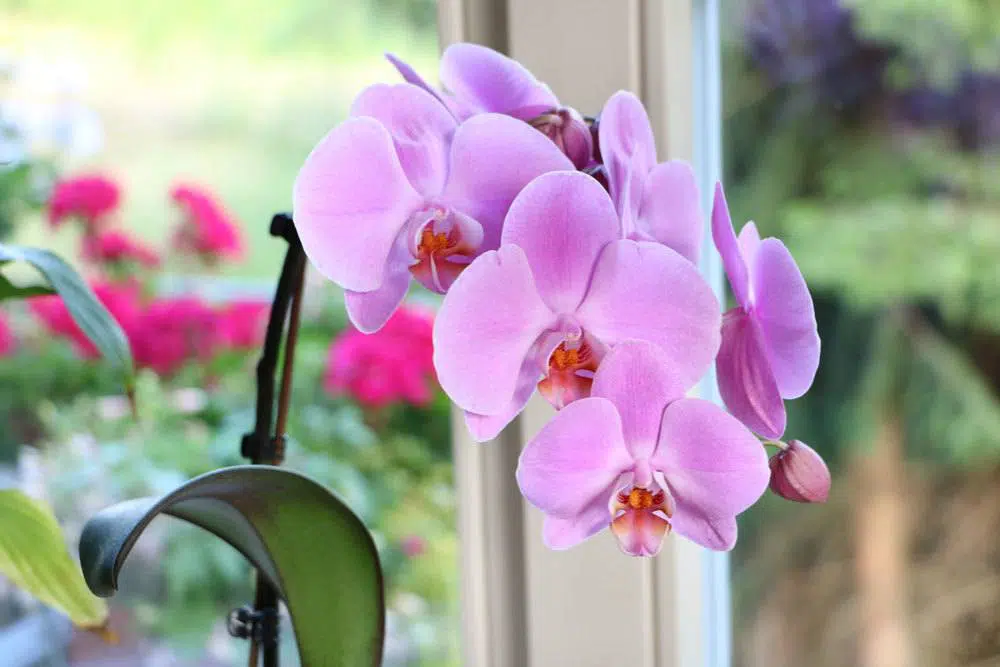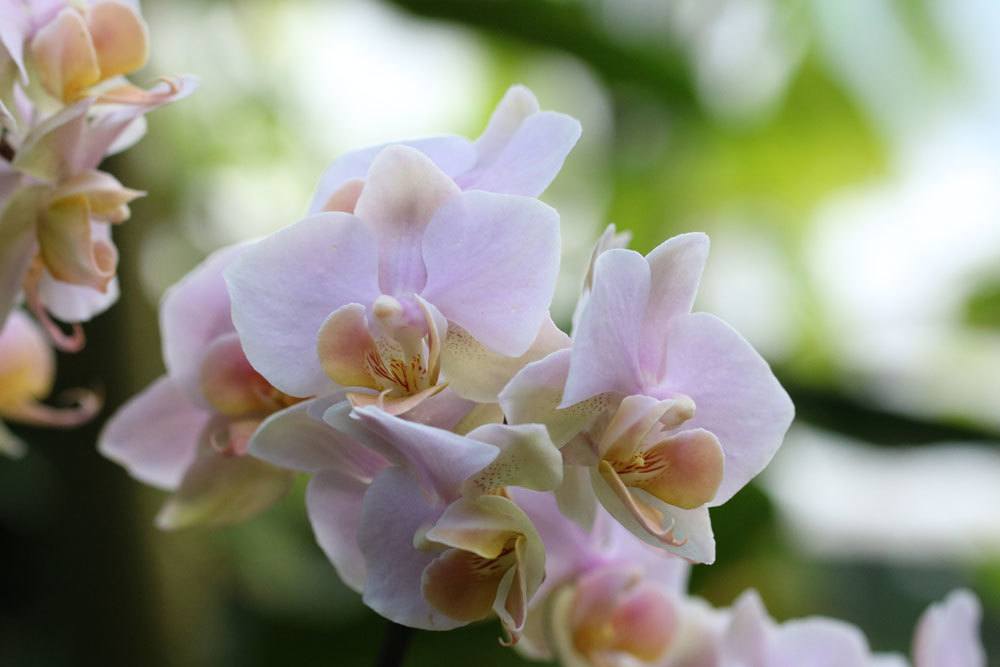Orchid, which its lovers also like to call the “queen of flowers”, captivates people with its beautiful flowers. However, the graceful beauty is also considered quite sensitive and sensitive to unfavorable site conditions and improper care. Quickly, the first symptom of the orchid is drooping flowers. For this phenomenon, various – and sometimes contradictory – reasons come into question, which is why a thorough investigation of the causes is necessary for the right help.
Orchid flowers drooping
If your orchid is drooping its beautiful petals after some time in bloom, a problem is not necessarily the cause. Most species display their splendor for about two months, but there are great differences between species in terms of timing and duration. After this phase is over, the flowers first begin to droop, and eventually dry up and fall off. Finally, the tips of the shoots wilt. This is a completely natural process, as the orchid now enters a dormant phase. Typically, the plant will not produce any new shoots at this point.
Tip: Many hybrid varieties, especially of the popular Phalaenopsis and Vanda orchids, no longer adhere to the natural flowering phases of their wild ancestors. Instead, these cultivated forms often produce new flowers all year round or take only very short breaks.
Countermeasures
Support the orchid in its rest, so that it draws strength for a renewed bloom. Optimal help is given by these measures:
- cut off withered flower shoots
- Place the flower in a cooler place
- depending on the species, not cooler than 15 °C to 18 °C
- Water less
- do not fertilize any more
As soon as new shoots form, the orchid ends its dormant phase and can be cultivated again in its usual location. After some time it will form new flower buds again.

Flowering duration of various Orchidaceae
A clue as to whether it is indeed a normal wilting process or an indication of a problem requiring treatment is provided by the species-typical flowering time and flowering duration. Keep in mind, however, that plants are also individuals – they don’t care when to do what any more than humans do. Therefore, the following information is only a guide.
- Cattleya: bloom between early January and early March
- Cymbidium: very long flowering period between October and March
- Dendrobium Phalaenopsis: very long flowering period between October and March
- Miltonia: blooms twice a year, in spring and in autumn
- Phalaenopsis: hybrid varieties bloom all year round
- Vanda: hybrid varieties bloom all year round, the species in spring and autumn
Note: If the flowers wilt one after another, there is often a natural wilting process behind it. However, if all the petals suddenly go limp, the plant usually has a problem. But be careful: some species of orchids go into dormancy very suddenly, so that the owner mistakenly suspects a disease. This is the case, for example, Miltonia orchids.
Causes
If natural withering of the petals can be ruled out, various causes may be considered instead. In this case, it is necessary to carefully investigate the actual reason for the phenomenon, in order to avoid possibly incorrect treatment of the affected orchid – this can possibly lead to the final death of the plant.
- changed environmental conditions
Especially a few days after purchase, orchids like to let their flowers droop and make a floppy impression. This behavior is quite normal and no reason for concern, after all, the plant is merely reacting to transportation and its circumstances (or movement, temperature fluctuations, etc.) as well as to its new, unfamiliar location. Also, natural withering of the flower pile may occur shortly after purchase. Finally, the flower in question may have been blooming for several weeks or months, so it is now entering its dormant phase.
Countermeasures
It is best to leave the already stressed plant alone and wait for it to acclimate and settle into its new location. With good care, it will soon form new flower buds, but this will require a few months of patience. Orchids are considered site-faithful and should not be moved if possible.
- lack of sunlight
With the exception of the terrestrial orchids, most orchidaceae grow as perching plants in the shelter of the tall jungle trees. Here, however, the plants sit as high up as possible, where they receive plenty of light – though not necessarily direct sunlight. If there is a lack of light, orchids quickly drop their flowers or even discard them. The reason for this behavior is weakness, because a lack of sunlight also means a lack of photosynthesis. The plants are particularly at risk during the dark winter months, when the sun shines less often anyway due to the shorter daylight hours.
Countermeasures
- optimal location in spring and summer: bright west or east window with evening or morning sun
- in autumn and winter: south window with protection from direct sunlight (if necessary)
- otherwise installation of daylight lamps or fluorescent tubes (light color 865)
- Illumination duration at least eight hours daily

- direct sunlight
However, not only a lack of light, but also an excess of sunlight causes the flowers to droop limply and wilt prematurely. This is especially true for orchids that are placed in full sun over midday, for example at a south-facing window. Morning or evening sun, on the other hand, is usually well tolerated.
Countermeasures
Move the affected plant to a less exposed location and watch for any signs of water deficiency.
- water shortage
A common reason for wilting flowers is lack of water. This causes not only the flower head, but also the leaves to droop limply at first and later dry up. Pay attention to the condition of the aerial roots: normally plump and green, they turn silvery and shiny when dry.
Countermeasures
In the event of drought, the most effective first aid is to dip the orchid in question so that it can soak up water. How it works:
- Remove the plant from the planter
- Fill bucket with well stagnant tap water or rainwater
- Put the plant with pot and substrate in it
- Keep it in the water for 10 to 15 minutes
- Immerse as long as air bubbles appear
- take out, let drain well
- do not put back into the planter until the substrate stops dripping
Allow the planting substrate to dry out quietly between dips; also, do not allow water to stand in the pots. Excess moisture will also cause premature wilting of the flowers – and in the worst case, waterlogging. As a guideline: during the warm summer months, water the orchid weekly, in autumn and winter much less frequently.
- too much water/ wrong watering
If there is an excess of water, quick action is necessary to even save the plant. Incorrect or excessive watering quickly leads to waterlogging in moisture-sensitive orchids. You can recognize this by the brownish to black discolored roots, which often become soft and/or are covered with a greenish film. These are algae, which also feel very comfortable in the moist environment. The same symptoms appear, by the way, if excess water is not poured off and the orchid stands in water.
Countermeasures
- Pot up the plant
- Remove all damp substrate
- let the plant dry for a day
- cut off darkly discolored and rotten roots
- also remove wilted flower shoots
- transplant into fresh substrate and a new pot
- do not water for about ten days
- only spray
Tip: Also avoid watering with chalky and / or cold water. Both damage orchids and cause them to droop flowers and drop buds.
- wrong location/ fruit
Do you like to eat apples? If so, having a basket of fruit in the same room as a blooming orchid is one of the most common causes of wilting flowers. The reason for this is the ripening gas ethylene, which not only ripens apples (and other fruit, too) – but also accelerates the aging process of orchid flowers. Characteristic of the gas is its sweet smell that permeates the room.
Countermeasures
Place either the fruit basket or the orchid – the latter only if there is no other way, after all a change of location is stressful for the plant – in separate rooms if possible.
- cold temperatures/ draught
Orchids originate from regions where it is consistently warm all year round. Consequently, these exotic beauties do not tolerate temperature fluctuations and react to changes of just five degrees Celsius by dropping their flowers. This is especially problematic during the winter months, when daily airing suddenly lets icy air into the room. But even in summer, an unfavorable, drafty location can cause the flowers to droop. Here, the plant suffers from drafts.
Countermeasures
Save the flower bloom by placing the orchid in a protected and evenly tempered location from the beginning. The ideal place should
remain consistently warm all year round
not be located above a radiator
not be located near a frequently opened window
Tip: Orchids purchased in winter often suffer cold shock during transport, as a result of which they shed their pile. Avoid this by wrapping the plant thickly with newspaper or other insulating material.


